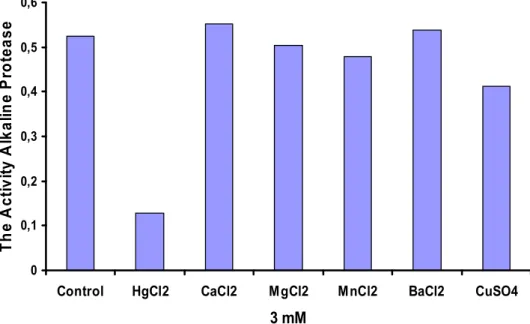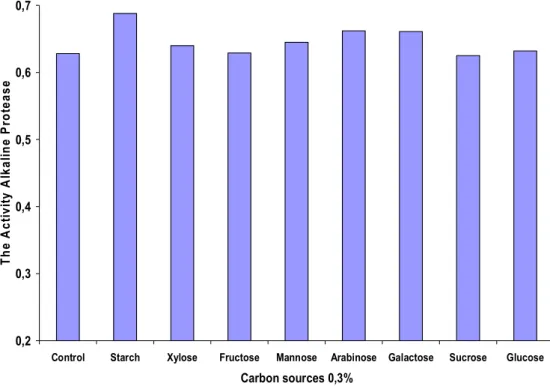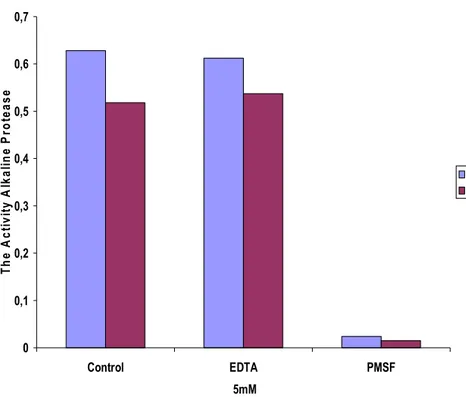D.Ü.Ziya Gökalp Eğitim Fakültesi Dergisi 9, 104-114 (2007)
THE OBTAİNMENT OF ALKALİNE SERİNE PROTEASE FROM BACİLLUS SP.
I
SOLATED FROMS
OLİD THROUGH THES
OLİD-S
TATEF
ERMENTATİONT
ECHNİQUE BYU
SİNGR
İND OF THECİTRULLUS LANATUS
L.
(
WATERMELON)
ANDCUCUMİS MELO
L.
(
MELON)
Citrullus lanatus L. (Karpuz) ve Cucumis melo L. (Kavun) Kabuğu
Kullanılarak Katı-Faz Fermentasyon Tekniği (SSF) ile Topraktan
İzole Edilen Bacillus sp.’den Alkalin Serin Proteaz Eldesi
Sema AGÜLOĞLU FİNCAN
1Veysi OKUMUŞ
2Özet
Bu çalışmada, ekonomik önemi olmayan ve birikerek çevre kirliliğine yol açan karpuz ve kavun kabuğu katı substrat olarak kullanılarak Katı-Faz Fermentasyonu (SSF) yöntemi ile Bacillus sp.’den yüksek miktarda alkalin serin proteaz eldesi amaçlandı.
Enzim aktivitesi üzerine pH, sıcaklık, metaller, azot ve karbon kaynakları etkisi incelendi. Yapılan inhibisyon çalışmasında PMSF ile inhibe olan enzimin alkalin serin proteaz olduğu tespit edildi.
SSF yöntemi ekstrasellular enzimlerin düşük masrafla, hızlı bir şekilde, bol miktarda ve çevreye zarar vermeden üretilebildiği bir yöntem olduğu için kullanıldı.
Anahtar kelimeler: Bacillus sp.; SSF; alkalin serin proteaz, kavun, karpuz Abstract
In this study it was aimed to obtain serine alkaline protease in high amount from Bacillus sp. through solid-phase fermentation method (SSF) by using watermelon and melon rinds of no economic importance, and cause environment pollution by accumulation, as solid substrate.
The effects of pH, temperature, metals, nitrogen and carbon sources were examined. In this inhibition study it was determined that the ezyme which is inhibited with PMSF (phenylmethylsulfonyl fluoride) was alkaline serine protease.
SSF method was used since extracellular enzymes could be produced at low cost, in a quick way, in plenty and without giving any harm to the environment.
Key words: Bacillus sp., SSF, alkaline serine protease, melon, watermelon
1. Introduction
Solid state fermentation (SSF) is defined as the fermentation involving solids in the absence or near absence of free water. The substrate must possess sufficient moisture to support growth and metabolism of microorganisms
1
Sema AGÜLOĞLU FİNCAN, University of Dicle, Faculty of Science and Art, Department of Biology, Diyarbakır- Turkey, semaagul@dicle.edu.tr
2
(Pandey,2003). The selection and optimization of appropriate parameters are important for the process. These can be arranged as the particle size of substrate, first moisture rate of the habitat, pH, the first preliminary process of the substrate, relative moisture, heat of the incubation, rinsing and ventilation, time and amount of planting, addition of the carbon sources and the trace element like N and P (Elibol, 2004; Pandey,2003).
Bacillus are the bacterium that make gram positive, endosporand
available in dust, soil fertilizer, plants, animals, milk, water and which are in the shape of cudgel. They are the specific producer of extracellular protease (Müderriszade,2001). Bacteria were always used to submerged fermentation (SmF ) and there was little literature about SSF of bacteria to produce alkaline protease (Gupta,2005;Müderriszade,2001;Patel,2006). However, SSF of alkaline protease would be more eco-friendly and economical than SmF because of less water consumed and lower cost of substrates and equipment (Aijun,2005;Asther,2002).
Proteases, one among the three largest groups of industrial enzymes, account for about 60% of the total worldwide sale of enzymes and is widely used in several industries that include detergent, leather processing, diary, preparation of organic fertilizer as digestive aid, silk industry and also for the recovery of silver from used X-ray films. Now protease are added as key ingredients in detergents, which accounts for approximately 25% of the total worldwide sales of enzymes and all detergent proteases currently used in the market are serin proteases produced using Bacillus sp (Chelappan,2006).
In this study, alkaline protease was obtained from Bacillus sp isolated from solid through the SSF technique by using watermelon and melon rinds as a solid substrate which cause environmental pollution and have no economic importance.
2. Material and Methods
2.1.Chemicals
Azocasein and TCA (trikloroasetik asit) were obtained from E.Merck, Darmstad, Germany. PMSF (fenilmetilsülfonilklorid), EDTA and other chemicals were purchased from Sigma Chemical Co., St.Louis, MO.,USA.
2.2. Microorganism
Alkalophilic Bacillus sp. was isolated from the soil.
2.3. SSF (Solid-state fermentation)
Watermelon rind, melon, rice, lentil, and corn husks were dried and blended. With the help of different sizes of sieves, four different partical sizes 500 µm, 1000 µm, 1500 µm, 2000 µm were obtained. 1,5 g and 1500 µm particle size from the substract was weighed and added into 50 ml erlenmayer
flasks amount of 3% erlenmayer flask volume. 5 ml 0.1 M of Tris (pH: 8) tampon was added and it was autoclaved.
2.4. Assay of alkaline protease
The enzyme activity was tested according to modified Leighton method (Leighton,1973). 5% commercial azocasein solution was prepared in the 0.1 M Tris (pH 8) tampon. After resuspended the 500 µl azocasein solution with 250 µl enzyme solution in the reaction tube, it was incubated for 30 min at 37oC. The reaction was stopped by adding 2 ml of 10% TCA solution. The samples were centrifuged in 5000 rpm for 5 minutes and then the solution was neutralized using 0.8 ml of 1.8 N NaOH. The absorbance was measured at 420 nm in a UV-Visible spectrophotometer. One unit of proteolytic enzyme was defined as the amount of azocasein tha hydrolysed during 1 h incubation at 37oC for 1 ml of solution of extract.
2.5. Determination of incubation time in different substr
ate The SSF medium with varying substrates (watermelon rind, melon rind, rice, lentil, and corn husk) inoculated with Bacillus sp., the cultures were incubated with shaking at 37oC for 144 hours.2.6. The effect of temperature on the enzyme activity
Samples were incubated at 25, 30, 35, 40, 45, 50, 55, 60, 65, 70, 75,
and 80 oC respectively for 30 min, then the enzyme activity was tested.
2.7. The effect of pH on the enzyme activity
The effect of pH on the enzyme activity were studied by using casein solutions in Tris buffer at pH ranging from 7.0 to 12.0.
2.8. The effects of some nitrogen and carbon sources on
enzyme activity
2.8.1.Nitrogen sources
After SSF solid medium was prepared, 10% of the substrate including different organic and inorganic materials that contains nitrogen (peptone, bacto-liver, casamino acids) was added to erlenmayer flasks and culture mediums were autoclaved. 1000µl bacteria cultures were cultivated after into the mediums and after 72 hours of incubation, activity determination was applied to each of the samples. After SSF solid medium was prepared, %10 of the substrate from different organic and inorganic, nitrogen containing substances was put into the erlenmeyer flasks and medium was left to be autoclaved. 1000 µl bacteria were cultivated to the media taken from autoclave and after a 72-hour incubation they were sampled and activity determination was done for each. Their effect on enzyme activity was studied.
2.8.2. Carbon sources
Different carbon sources (starch, xylose, fructose, arabinose, galactose, sucrose, glucose) with a rate of 0.3% of the substrate were dissolved in 2 ml tampon.These carbon sources were added in mediums, and after 72 hours of incubation. With the results of the activity determinations, the effects of the carbon sources were observed. To the SSF solid medium 2 ml incomplete buffer was left and autoclaved. Different carbon sources solved at %0,3 of the substrate in 2 ml buffer was added to the autoclaved media before cultivation. Then, cultivation was applied to the samples and they were left to incubation. As a result of the conducted activity determination, the effect of carbon sources to the enzyme activity was studied.
2.9. Metal solutions
The stock metal solutions (HgCl2, CaCl2, MgCl2, MnCl2, BaCl2, CuSO4) prepared in 0.1 M concentration were left to 15 min of incubation in total reaction volume to be 3 mM. 22.5 µl (concentration in total reaction size as 3 mM) was taken from stock metal solutions (HgCl2, CaCl2, MgCl2, MnCl2, BaCl2, CuSO4) prepared at 0.1 M concentration and was separately added to the 250 µl enzyme solution, and left 15 minutes for fore incubation. The enzyme activity was determined.
2.10. Inhibition studies
The proteolytic activity as assayed after incubating the enzyme with PMSF (Phenylmethylsulphonyl fluoride) and EDTA (etilendiamine tetraacetic acid). 37.5 µl was separately taken from EDTA and PMSF prepared at 0,1 M concentration and left to 250 µl enzyme in reaction tubes, and left to 15-minute fore incubation. Then, activity determination was conducted.
3. Results and Discussion
The subsequent experiments were conducted with these two substrates because the highest activity was firstly seen in watermelon rind and secondly in melon rind among five substrates (melon rind, watermelon rind, rice, lentil and corn husks) used.
As a result of incubation determination studies, in which watermelon and melon rinds are used as solid substrate, it was observed that incubation duration was 72 hours (Fig 1).
0 0,1 0,2 0,3 0,4 0,5 0,6 0,7 24 48 72 96 120 144
Incubation Time (Hour)
T h e a c ti v it y a lk a li n e p ro te a s e Melon Watermelon Rice Corn Lentil
Fig 1: Determination of appropriate incubation duration for alkaline protease in different substrates
It was observed the optimum pH was 10 and optimum temperature was 65°C (Fig 2,3). 0,4 0,5 0,6 0,7 0,8 7 8 9 10 11 12 pH T h e A c ti v it y A lk a li n e P ro te a s e Melon Watermelon
0 0,1 0,2 0,3 0,4 0,5 0,6 0,7 0,8 0,9 25 30 35 40 45 50 55 60 65 70 75 Temperature (C) T h e A c ti v it y A lk a li n e P ro te a s e Melon Watermelon
Fig 3: The effect of temperature on the activity alkaline protease
Fujiwara ve Yamamoto reported that optimum temperature was 60°C and optimum pH was 11.5 in the alkaline serine protease activity that was obtained from the Bacillus sp. which was isolated from soil (Fujiwara, 1987). Johnvesly and Naik showed that in the alkaline protease activity that they obtained from Bacillus spJB-99 optimum temperature was 70°C and optimum pH was 11.0 (Johnvesly,2001). In our study while the effect of the heat and pH on enzyme activity was examined, it was seen that optimum temperature was 65°C and optimum pH was 10. These results are compatible with the findings of Fujiwara and Yamamoto and Johnvesly and Naik.
When the effect of the metals on enzyme activity was observed, it was understood that among the metals that were prepared in 3 mM concentration HgCl2 could inhibate into enzyme activity, strongly but the inhibition of CuSO4, was partial it was observed that will CaCl2 and BaCl2 the enzyme activity increased relatively and there wasn’t such a big increase with other metals(Fig 4).
0 0,1 0,2 0,3 0,4 0,5 0,6
Control HgCl2 CaCl2 MgCl2 MnCl2 BaCl2 CuSO4
3 mM T h e A c ti v it y A lk a li n e P ro te a s e
Fig 4: The effect of some metals on enzyme activity.
Agrawal et al. stated that alkaline protease that they obtainedfrom
Penicillium sp with SSF method could inhibate with Hg2+ and Cu2+and it increased the activity amount with Ca2+ (Agrawal,2004). This observations support that the studies of the Agrawal et al. It was observed that the 3% carbon sources added in SSF medium increased the enzyme production of starch and other carbon sources didn’t a striking change enzyme production (Fig 5).
0,2 0,3 0,4 0,5 0,6 0,7
Control Starch Xylose Fructose Mannose Arabinose Galactose Sucrose Glucose
Carbon sources 0,3% T h e A c ti v it y A lk a li n e P ro te a s e
Fig 5: The effect of carbon sources on enzyme activity
It was determined that among 10% of the nitrogen sources added in SSF mediums; peptone and ammonium sulphate increased the enzyme production, ammonium chloride and ammonium nitrate decreased the enzyme production (Fig 6).
0 0,1 0,2 0,3 0,4 0,5 0,6 0,7 0,8 0,9
Control Peptone Ammonium
sulphate Ammonium chloride Ammonium nitrate T h e A c ti v it y A lk a li n e P ro te a s e
Fig 6: The effect of nitrogen sources on enzyme activity
Puri et al. have emphasized in their work with the title ‘Effects of C and N on production of protease from Bacillus sp’ that the most suitable carbon source added to fermentation medium was %1 starch and the most suitable nitrogen source was %0,5 peptone. As a result of the study, since it was found that the most suitable carbon source was starch and that the most suitable nitrogen source was peptone, the obtained result shows it supports the study conducted by Puri et al. (Puri,2002).
In the study with EDTA and PMSF, it was observed that the enzyme inhibited with PMSF was alkaline serine protease (Fig 7).
0 0,1 0,2 0,3 0,4 0,5 0,6 0,7 Control EDTA PMSF 5mM T h e A c ti v it y A lk a li n e P ro te a s e Melon Watermelon
Fig 7: Determination of inhibitor effect enzyme activity
Germano et al. reported that the protease they obtained from
Penicillium by SSF method was inhibited with 93% by 3 mM PMSF and 23%
rate by 5 mM EDTA (Germano,2003).
As a result, it was determined that the watermelon and melon rind could be used in enzyme production as alternative substracts by SSF method. It is believed that usage of the waste materials in enzyme production is economical and it prevents pollution. As the protease obtained from Bacillus
sp. preserved its activity in wide pH and temperature values, it incdicated that
enzyme can be used with industrial purpose especially in detergent sector. References
Agrawal, D., Patidar, P., Banerjee, T. & Patil, S. (2004) Production of alkaline protease by
Penicillium sp. under SSF conditions and its application to soy protein hydrolysis.
Process Biochemistry 39 977-981.
Aijun,Z., Hongzhang,C. & Zhou,L., (2005) Air pressure pulsation solid state production of alkaline protease by Bacillus pumilus 1.1625. Process Biochemistry, 40, 1547-1551. Asther, M., Haon, M., Roussos, S., Record, E., Delattre, M., Lesagemeessen, L., Labat, M. &
Asther, M. (2002) Feruloyl esterase from Aspergillus niger comparison of the production in solid state and submerged fermentation. Process Biochemistry 38, 685-691.
Chelappan,S, Jasmin,C., Basheer,S.M., Elyas,K.K., Bhat,S.G., & Chandrasekaran,M. (2006) Production, purification and partial characterization of a novel protease from marine
Engyodontium album BTMFS10 under solid state fermentation. Process Biochemistry 41, 956-961
Elibol,M & Antonio,R.M. (2004) Optimizing some factors affecting alkaline protease production by a marine bacterium Teredinobacter turnirae under solid state fermentation. Process Biochemistry Article in press.
Fujiwara,N. & Yamamoto,K. (1987) Production of alkaline protease in a low-cost medium by alkalophilic Bacillus sp. and properties of the enzyme. Fermentation Technology 65, 345-348.
Germano,S., Pandey, A., Osaku, C.A., Rocha, S.N. & Soccol, C.R. (2003) Characterization and stability of proteases from Penicillium sp. produced by solid state fermentation. Microbial Technology 32, 246-251.
Gupta, A., Roy, I., Patel, R.K., Singh, S.P., Khare, S.K. & Gupta, M.N. (2005) One-step purification and characterization of an alkaline protease from haloalkaliphilic Bacillus
sp. Journal of Chromatography A, 1075, 103-108.
Johnvesly,B. & Naik, G.R. (2001) Studies on production of thermostable alkaline protease from thermophilic and alkalophilic Bacillus sp. JB-99 in a chemically defined medium. Process Biochemistry 37139-144.
Leighton,T.J., Doi,R.H., Warren,R.A.J. & Kelln, R.A. (1973) The relationship of serin protease activity to RNA polymerase modification and sporulation in Bacillus subtilis. Journal of Molecular Biology 22 76-103.
Müderriszade, A., Ensari, N.Y., Aguloglu, S. & Otludil, B. purification and characterization of alkaline proteinase from alkalophilic Bacillus sp. Applied Biochemistry and Microbiology, 37(2001) 574-577.
Pandey,A. (2003) Solid-state fermentation. Biochemical Engineering Journal 13 81-84.
Patel, R.K., Dodia, M.S., Joshi, R.H. & Singh, S.P. (2006) Purification and characterization of alkaline protease from a newly isolated haloalkaliphilic Bacillus sp. Process Biochemistry, 41, 2002-2009.
Puri, S., Beg, Q.K. & Gupta, R. (2002) Optimization of alkaline protease production from





